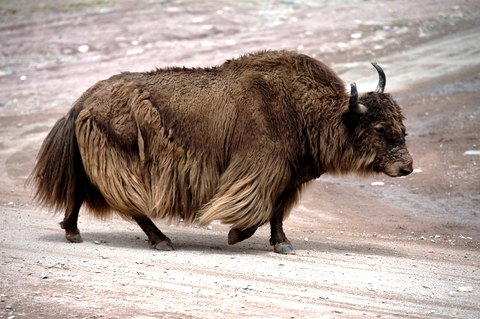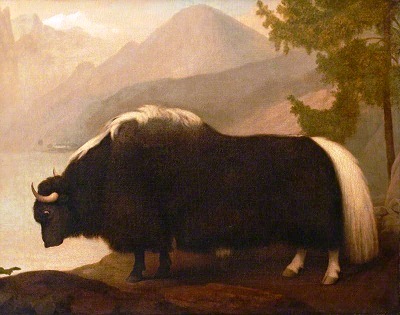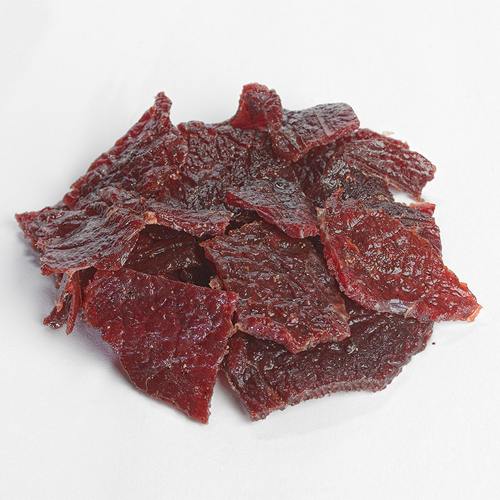
Yaks were ‘discovered’ in a big way by westerners in the late 18th Century when British Captain, Samuel Turner admired them in Bhutan and sent a pair back to his cousin Warren Hastings in England.

In Asia, I have enjoyed yak meat in stir fries, stews, curries and kebabs and found it a delicious, lean and sweet meat. Depending on the cut and the age of the meat, yak can be tough and tenderizing or marinating is a must. One of my favorite recipes is a stew I had again last year in Tashkorgan in which Yak meat is paired with bell peppers, onions, lots of garlic and chilies, and cooked in a ginger and star-anise rich sauce. Served on a bed of rice, the dish is pretty because of the strips of multicolor peppers, savory, a bit hot, and delicately sweet all at the same time.
In contrast to the sweetness of the yak meat, yak dairy lends a sour blast to beverages and dishes that produces a delicious pucker. Yak butter or cream in tea is a survival standard throughout the Himalayas and Pamirs, and the cheese, sometimes made as a wind-blown-in bleu, lends a unique tanginess to meat, vegetable and even fruit dishes throughout the region. I have a mind-blowingly delicious recipe from Bhutan combining tomatillos or tamarillos (or any ‘tree tomato”) with yak cheese for a salad with a real zing – but I digress.
My favorite way to enjoy yak on the fly is with yak jerky. Available fresh at markets and bazaars and packaged every Chinese airport shop I’ve ever been in, yak jerky comes in three general varieties, sweet, sweet and hot with lots of chilies, and sweet and tangy with a mix of black and Szechuan pepper. There are a lot of variations in between, usually found in markets, but these three are the ones I’ve seen most frequently.
Yak Jerky
Ingredients
4 cups unsweetened pomegranate juice
2 cups shaoxing wine
1 cup soy sauce
¼ cup apple cider vinegar
1 tablespoon lemon juice
2 yellow onions, peeled and minced
6 cloves of garlic thinly sliced
¼ cup jaggery or cane sugar
2 tablespoons sea salt
2 tablespoons black peppercorns, lightly crushed
1 tablespoons cumin seeds, roughly ground
10 finger-hot chilies, minced
Peel of 1/2 orange, diced
Directions
Slice the meat crosswise in 1/8 – 1/4 inch slices. An excellent wayto do this is to partially freeze the roast to make it firm and easy to cut. Trim the fat from the slices and pound lightly with the handle of the knife to thin out the meat. When slices are mildly translucent, slice again into strips for jerky and set aside.
In a non-reactive vessel, such as a plastic, glass, or ceramic bowl large enough to hold both marinade and meat, combine marinade ingredients. Place meat into marinade and make sure it is completely submerged. Cover bowl and let sit for at least 24 -48 hours in a cool or cold spot (not freezing). Check on the marinade and stir occasionally to make sure that the meat is evenly coated.
When meat is finished marinating, remove from the marinade and arrange on baking racks set into baking sheets with some space between the slices. If using a conventional oven to dehydrate the meat, line the bottom of the oven with aluminum foil and preheat to 150 – 160 degrees Fahrenheit. If you run out of baking sheets, the meat strips can be placed directly on the racks in the oven.
Place cookie sheets with meat strips in the oven and keep the oven door ajar with a wooden spoon or crushed can and cook for 2 hours. Flip strips and cook for another 2-3 hours or until done. The amount of cooking that it takes to dehydrate the meat will depend on the thickness of the slices, the amount of time marinated and the innate moistness of the meat. To determine whether the jerky is done, take a piece or two out and let cool for 5-10 minutes then test the pliancy of the jerky. It should bend without snapping and not appear too red or raw on the inside. (Words and recipe by Laura Kelley)

